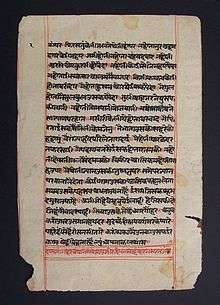Printing and writing paper

Ancient Sanskrit on Hemp based Paper. Hemp Fiber was commonly used in the production of paper from 200 BCE to the Late 1800's.
Printing and writing papers are paper grades used for newspapers, magazines, catalogs, books, commercial printing, business forms, stationeries, copying and digital printing. About 1/3 of the total pulp and paper marked (in 2000) is printing and writing papers.[1] The pulp or fibers used in printing and writing papers are extracted from wood using a chemical or mechanical process.[2]
In the United States printing and writing papers are separated into four main categories:[3]
- Uncoated Freesheet Paper
- Uncoated Mechanical Paper
- Coated Freesheet Paper
- Coated Mechanical Paper
Writing paper standards
| Specifications | MD/CD | Unit | Level A | Level B | Method |
|---|---|---|---|---|---|
| Substance | gsm | 80-120 | 60-80 | TCVN 1270:2000 | |
| Durable ≥ | mN.m²/g | TCVN 3229:2000 | |||
| MD | 5.7 | 4.1 | |||
| CD | |||||
| Tearing strength ≥ | m | TCVN 1862:2000 | |||
| MD | 3800 | 3200 | |||
| CD | 2200 | 1800 | |||
| Water absortiveness Cobb 60 | g/m² | 23 | 23 | TCVN 6726:2000 | |
| Brightness ISO ≥ | % | 78 | 70 | TCVN 1865:2000 | |
| Opacity ≥ | % | 85 | 85 | TCVN 6728:2000 | |
| Roughness Bendtsen ≥ | ml/ minute | 280 | 400 | TCVN 3226:2001 | |
| Ash content ≥ | % | 3 | 3 | TCVN 1864:2001 | |
| Moisture content | % | 7±1 | 7±1 | TCVN 1867:2001 |
Types
History
| Wikimedia Commons has media related to Writing paper. |
References
- ↑ Paulapuro, Hannu (2000). "Chapter 1". Paper and Board grades. Papermaking Science and Technology. 18. Finland: Fapet Oy. pp. 14–51. ISBN 952-5216-18-7.
- ↑ "Printing and Writing Paper: What's The Difference". Clash Graphics. Retrieved August 1, 2015.
- ↑ "Printing and Writing Paper". American Forest & Paper Association. Retrieved August 1, 2015.
This article is issued from Wikipedia - version of the 8/25/2016. The text is available under the Creative Commons Attribution/Share Alike but additional terms may apply for the media files.